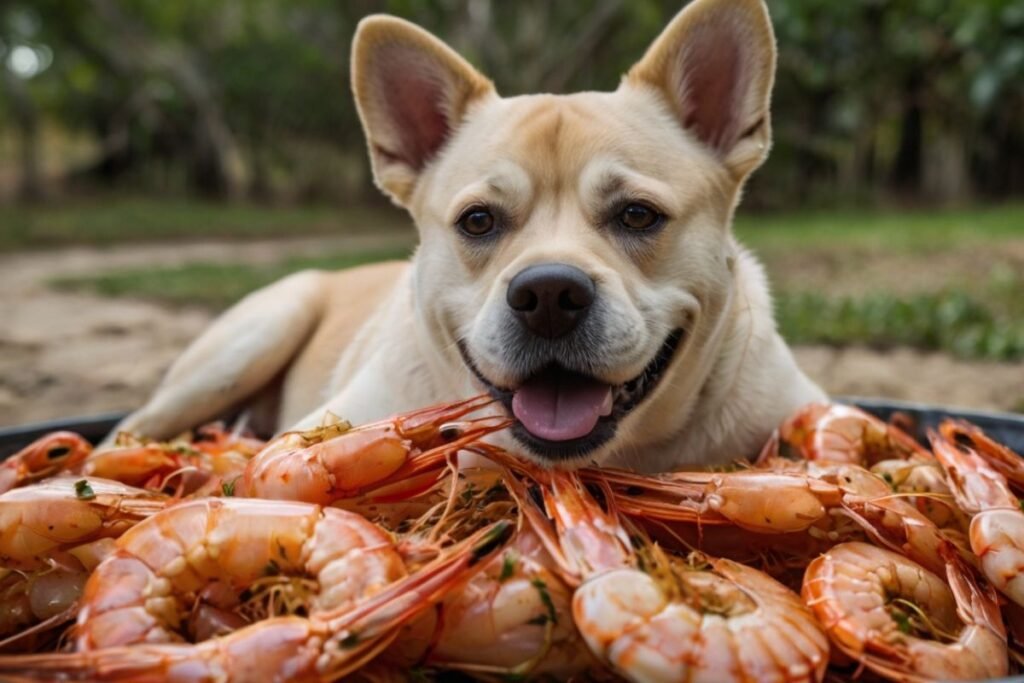I’ll never forget the first time my furry buddy gave me those eyes during shrimp night. You know the look I’m talking about. That hopeful, pleading stare that melts your heart instantly. I found myself wondering if I could share this tasty treat.
As a devoted dog parent, I’ve been there countless times. We want to include our four-legged family members in everything. Food becomes one of those bonding moments. However, I learned the hard way that not all human foods work for our pups.
After years of experience and plenty of research, I’m here to share what I’ve discovered about dogs and shrimp. This isn’t just textbook knowledge. It’s real-world wisdom from someone who’s navigated these waters with my own beloved companion.

Table of Contents
Here’s What I’ve Learned: Yes, But Let’s Talk Details
My dog can enjoy shrimp safely, and yours probably can too. However, I’ve learned some non-negotiable rules along the way. First, it must be plain and properly cooked. Second, I always remove every bit of shell and tail. Third, I treat it like the special occasion it is.
I think of shrimp as birthday cake for dogs. It’s not an everyday thing. Furthermore, I’ve discovered that every pup has their own tolerance levels. What my friend’s golden retriever handles easily might not work for my more sensitive companion.
Read, Can Dogs Eat Mango?
Why I Started Caring About This Topic
Like many dog parents, I used to think human food was human food. Then I realized how much our furry friends mean to us. Moreover, I wanted to understand what I was actually feeding my beloved companion.
Shrimp caught my attention because it’s packed with good stuff. It has quality protein that helps build those strong muscles I love to pet. Additionally, it contains vitamins that support overall health. Plus, it’s not loaded with calories like many treats.
However, I also learned about the flip side. Some dogs react badly to shellfish. Furthermore, shrimp has cholesterol that can cause problems. Therefore, I knew I needed to dig deeper before making it a regular thing.
The Good Stuff: Why I Sometimes Share Shrimp
Protein That Actually Matters
I’ve always been picky about what goes into my dog’s body. Protein is huge for maintaining those muscles that power our daily walks. Furthermore, good protein keeps that gorgeous coat shiny and soft.
Shrimp delivers what I call “complete protein.” This means it has all the building blocks my pup needs. Additionally, this protein helps with energy during our park adventures. Therefore, when I do share shrimp, I feel good about the nutrition.
Vitamins That Make a Difference
I love knowing exactly what nutrients I’m providing. Shrimp contains vitamin B12 for nervous system health. It also has phosphorus for strong bones and teeth. Plus, selenium works as a natural protector against cell damage.
These aren’t just fancy words on a label. They’re real benefits I can see in my dog’s energy and vitality. Moreover, they support the immune system that keeps my companion healthy. Also, they help with proper organ function throughout the body.
A Treat That Won’t Pack on Pounds
I worry about weight gain because I’ve seen too many overweight dogs struggle. Many commercial treats are calorie bombs. However, shrimp is naturally low in calories while still being satisfying.
Additionally, the protein helps my dog feel full and content. This means less begging and food obsession. Furthermore, a satisfied pup is a happy pup, and that makes me happy too.
The Scary Stuff: What Keeps Me Cautious
Allergic Reactions Hit Close to Home
I learned about shellfish allergies the hard way. My neighbor’s dog had a reaction that scared us both. Furthermore, these reactions can happen fast and be serious. Therefore, I always watch like a hawk after trying any new food.
The signs I watch for include excessive scratching, facial swelling, and stomach upset. Additionally, breathing problems can happen with severe reactions. Moreover, I’ve learned that some reactions are life-threatening. Therefore, I keep my vet’s number handy.
Cholesterol Reality Check
I used to think cholesterol was just a human concern. Then I learned that dogs process it differently, but it still matters. Furthermore, too much can trigger pancreatitis, which I’ve seen devastate families.
Additionally, dogs with existing health issues are more vulnerable. Moreover, pancreatitis is painful and expensive to treat. Therefore, I keep portions tiny and infrequent to stay on the safe side.
Tummy Troubles I Want to Avoid
Rich foods can wreak havoc on sensitive stomachs. Furthermore, I’ve cleaned up enough messes to know prevention is worth everything. Shrimp’s richness can trigger vomiting, diarrhea, and general misery.
Additionally, some dogs have more sensitive systems than others. Moreover, sudden diet changes make everything worse. Therefore, I always introduce new foods slowly and watch carefully.
My Step-by-Step Safe Preparation Method
Picking the Right Shrimp
I always choose fresh, high-quality shrimp from trusted sources. Frozen works fine if I thaw it properly. However, I avoid anything pre-seasoned or flavored. Additionally, I check for any funky smells or colors.
Moreover, I prefer wild-caught when possible because it typically has fewer additives. Furthermore, wild shrimp often tastes better and has better nutrition. Also, I feel better about the source.
Cooking It Right Every Time
I never, ever give raw shrimp to my dog. Raw seafood can harbor nasty bacteria and parasites. Therefore, I always cook it thoroughly until it’s completely pink.
I stick to simple boiling for 2-3 minutes. Additionally, steaming works great too. Moreover, I never use oils, butter, garlic, or any seasonings. Plain and simple keeps my pup safe.
Shell Removal Is Non-Negotiable
Every single piece of shell and tail comes off before my dog gets near it. These parts are choking hazards that scare me. Furthermore, they can cut up the mouth, throat, and digestive system.
Moreover, shells are impossible to digest properly. Also, sharp pieces can cause internal damage. Therefore, I double and triple-check that everything is removed completely.
Keeping It Plain and Simple
My dog gets plain, cooked shrimp or nothing at all. I learned that garlic and onions are toxic to dogs. Furthermore, salt and spices cause unnecessary problems. Additionally, butter and oils add calories and potential upset.
Therefore, I keep it boring by human standards but perfect for my furry friend. Simple preparation means safer eating and fewer worries for me.
Portion Control: Learning from Experience

Small Dogs Need Tiny Amounts
My friend’s chihuahua taught me that size really matters. Small dogs need just one tiny piece to start. Additionally, I watch for 24 hours before considering more. Moreover, small dogs get overwhelmed easily.
Furthermore, their little systems are more sensitive to rich foods. Therefore, I’m extra careful with portions. Also, what seems tiny to me might be huge to a 10-pound dog.
Medium Dogs Get Moderate Portions
My medium-sized pup can handle 2-3 small pieces safely. However, I still start small and work up slowly. Additionally, I pay attention to individual tolerance levels.
Moreover, I consider activity level and overall health. Also, a couch potato needs less than an active hiking buddy. Furthermore, every dog is different regardless of size.
Large Dogs Still Need Limits
Big dogs often have big appetites and big attitudes about food. However, size doesn’t guarantee tolerance. Therefore, I still practice portion control even with larger breeds.
Furthermore, big dogs can beg more convincingly. Additionally, they might seem like they can handle more. However, rich foods affect all dogs similarly regardless of size.
Red Flags I Watch For
Immediate Warning Signs
I learned to recognize trouble fast. Excessive drooling, pawing at the mouth, or choking motions worry me immediately. Additionally, difficulty breathing or swallowing means emergency vet time.
Moreover, vomiting within hours of eating shrimp is concerning. Also, unusual panting or restlessness can signal problems. Furthermore, I trust my gut when something seems off.
Problems That Show Up Later
Some reactions take time to develop. Therefore, I stay vigilant for 1-2 days after trying shrimp. Additionally, changes in appetite or energy levels catch my attention.
Moreover, skin problems might not appear right away. Also, digestive upset can be delayed. Furthermore, I’ve learned that patience and observation are key.
When I Call the Vet
I don’t mess around with severe symptoms. Breathing problems, persistent vomiting, or collapse mean immediate professional help. Additionally, my vet knows I’d rather be safe than sorry.
Moreover, I trust my instincts as someone who knows my dog best. If something feels wrong, I seek help. Furthermore, peace of mind is worth the vet visit.
Special Situations I’ve Encountered
Puppies Need Extra Protection
Young pups have developing systems that can’t handle rich foods well. Therefore, I wait until at least 6 months before introducing anything like shrimp. Additionally, puppies need consistent nutrition from quality puppy food.
Furthermore, their immune systems are still maturing. Also, they’re more prone to developing food sensitivities. Moreover, treats should be minimal during this crucial growth period.
Senior Dogs Require More Care
Older dogs often have health issues that complicate food choices. Additionally, their digestive systems become more sensitive with age. Moreover, medications can interact with rich foods.
Furthermore, senior dogs are more prone to pancreatitis. Also, they might have kidney issues that affect food tolerance. Therefore, I’m extra cautious with my aging companions.
Health Conditions Change Everything
Dogs with allergies, diabetes, or digestive problems need individualized approaches. Additionally, overweight dogs shouldn’t have high-calorie treats. Moreover, kidney problems mean watching phosphorus intake.
Furthermore, I always check with my vet before introducing new foods to dogs with health issues. Also, professional guidance beats internet advice every time.
Other Options When Shrimp Doesn’t Work
Fish Alternatives I Trust
Many fish work well for dogs when prepared properly. Salmon, sardines, and tuna can be great choices. However, they must be cooked and boneless. Additionally, I avoid canned varieties with added salt.
Moreover, fish provides similar protein benefits to shrimp. Also, many dogs love the taste. Furthermore, fish is often easier to digest than shellfish.
Traditional Protein Treats
When seafood isn’t the answer, I turn to reliable alternatives. Chicken, turkey, and lean beef usually work well. Additionally, eggs provide excellent protein.
Moreover, these options are typically less expensive. Also, they’re easier to find and prepare. Furthermore, most dogs prefer familiar meat flavors anyway.
My Philosophy on Treats and Balance
The Rule That Changed Everything
I follow the 90/10 guideline religiously. This means 90% of calories come from complete dog food. Only 10% comes from treats and extras like shrimp.
Additionally, this approach maintains proper nutrition. Moreover, it prevents weight gain from too many treats. Furthermore, it ensures my dog gets all necessary nutrients from quality food.
Variety Within Reason
I like offering different treats occasionally. However, I never forget that moderation is everything. Additionally, rotating treats prevents boredom. Moreover, it reduces the risk of developing food sensitivities.
Furthermore, different treats provide different nutrients. Also, variety keeps things interesting for my pup. However, I always introduce new items carefully and gradually.
Making the Decision That’s Right for You
Every dog is unique, just like every dog parent. What works for my situation might not work for yours. Therefore, consider your pup’s individual needs, health, and your comfort level.
Moreover, when in doubt, ask your vet. They know your dog’s history best. Furthermore, they can give personalized advice based on your specific situation.
Also, remember that dogs don’t need shrimp to be happy. There are countless other ways to show love. Therefore, don’t feel pressured if shrimp doesn’t feel right for your family.
My Final Thoughts as a Fellow Dog Parent
Shrimp can be a wonderful occasional treat for many dogs. However, it requires careful thought and preparation. Furthermore, our dogs’ safety must always come first, even when those puppy eyes are working overtime.
I’ve learned to cook it properly and remove all shells without exception. Additionally, I start with tiny amounts and watch carefully. Moreover, I never let my guard down just because previous attempts went well.
Most importantly, I trust my instincts as someone who loves my dog deeply. You know your pup better than anyone else. Therefore, make decisions based on their needs and your peace of mind.
Finally, remember that the best treats are given with love and careful consideration. Whether it’s shrimp or something completely different, your thoughtfulness is what your furry family member truly treasures.
By sharing my experiences and lessons learned, I hope you feel more confident about making the right choice for your beloved companion. Moreover, remember that being a caring, cautious dog parent is always the right approach.

Shahriar Robin is the creator of WhatPetsCanEat.com, a passionate pet lover and dedicated cat dad to Rio, a curious two-year-old orange feline who inspired this website. With a love for animals and a knack for research, Shahriar shares trusted, easy-to-understand information to help fellow pet owners make safe, healthy food choices for their furry friends.


